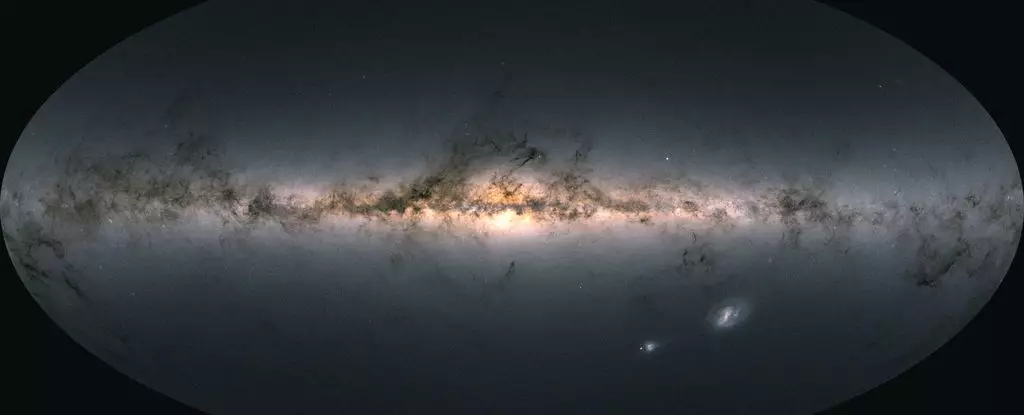The vastness of our universe is filled with phenomena that often challenge our understanding of physics and astrophysics. One of the latest revelations centers around a potential supermassive black hole residing in the Large Magellanic Cloud (LMC), a dwarf galaxy orbiting the Milky Way. Astrophysicist Jiwon Jesse Han and his team have proposed that this black hole could be about 600,000 times the mass of our Sun, a discovery that not only enriches our knowledge of black hole formation but also hints at a future collision between our galaxy and the LMC. This article will delve into the implications of this discovery, the technological advancements that made it possible, and the broader consequences for our understanding of cosmic evolution.
Black holes, especially those outside the gravitational influence of larger galaxies, can be remarkably elusive. Unlike stars and other celestial bodies, they do not emit detectable radiation unless they are drawing in nearby matter, a process often marked by intense energy release. Therefore, astrophysicists must adopt indirect methods to identify their presence. Han and his colleagues employed an innovative strategy, shifting the traditional focus from star orbits to so-called hypervelocity stars—anomalous stars moving at extraordinary speeds.
Hypervelocity stars are particularly significant because their immense speeds can hint at gravitational encounters with massive objects, including black holes. The Hills mechanism, a process involving the interaction of a black hole and two stars, provides an explanation for how these stars may be flung across space. By examining the velocities and trajectories of hypervelocity stars, researchers can extrapolate potential black hole locations without directly observing them.
The advancements in observational technology, particularly the data gathered by the recently retired Gaia space telescope, were pivotal in Han’s research. Gaia executed a comprehensive three-dimensional mapping of the Milky Way, tracking star positions and velocities with unprecedented precision. This wealth of data enabled an in-depth analysis of 21 hypervelocity stars identified in the Milky Way’s outer halo, revealing a pattern that aligned with the predictions of the Hills mechanism.
Armed with this information, the researchers could trace the origins of 16 stars back to their launch points. They established that a portion came from the Milky Way’s center, centered around Sagittarius A*, but crucially, others appeared to have originated from the LMC. This revelation of a potential black hole hiding within the LMC adds a fascinating dimension to our understanding of galactic relations.
The Future of Galactic Collision
Currently situated about 160,000 light-years away, the LMC is slowly spiraling into the Milky Way. Although this merger is projected to occur in roughly 2 billion years, the long-term consequences are dramatic. If the existence of the hidden black hole is confirmed, it would eventually contribute to the merging process when the LMC collides with our galaxy. Over immense timescales, it could join forces with Sagittarius A*, leading to an even larger black hole—a scenario that could provide invaluable insights into the growth of supermassive black holes from smaller origins.
This potential merger is not merely an esoteric concern confined to the realms of astrophysics; it challenges our understanding of cosmic evolution and black hole formation. The current paradigm suggests that black holes grow over eons, partly through the accumulation of surrounding matter, including gas and stars. Detecting a black hole just beneath the threshold of one million solar masses, as proposed here, provides an additional layer of complexity to this model.
Understanding the existence and properties of this hypothesized black hole will enhance the broader framework within which black holes are studied. Every new data point offers a fresh opportunity to refine or reassess existing theories about black hole behavior, growth patterns, and their role in cosmic evolution. If confirmed, findings regarding the black hole in the LMC could elucidate how these massive entities transition from smaller progenitors to grand cosmic titans, shining a light on processes that have unfolded across the universe for billions of years.
The detection signs of a potentially large black hole in the Large Magellanic Cloud opens new avenues for research and exploration. The integration of advanced observational techniques and innovative theoretical frameworks reveals the intricate and often hidden relationships among galaxies. While we may not witness the ultimate merging of the Milky Way and LMC, the ongoing study of these celestial bodies will deepen our understanding of the cosmos and our place within it. As research continues, we remain on the brink of discovering just how interconnected our universe truly is.


Leave a Reply